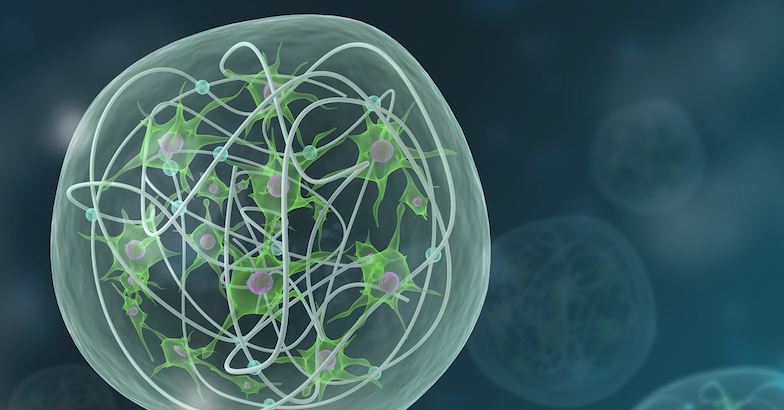Investigators at CÚRAM, the Science Foundation Ireland Research Centre for Medical Devices based at NUI Galway, have demonstrated the efficacy of mesenchymal stem cells (MSCs) delivery using a three-dimensional microgel platform, to assist with tissue repair in patients suffering from critical limb ischemia and other peripheral arterial diseases. Peripheral arterial disease is a chronic vascular disease characterised by impaired circulation to the lower extremities. Its most severe stage, known as critical limb ischemia (CLI), puts patients at an increased risk of cardiovascular events, infected and non-healing wounds, amputation, and death.
CLI affects millions of patients globally. Advancing age combined with other risk factors such as diabetes and smoking suggests that the condition will only increase in the near future”.[1] CÚRAM’s research in innovative ‘smart’ medical devices and implants aims to benefit patients with chronic soft tissue ailments such as CLI, as well as cardiovascular, musculoskeletal, neural, renal and respiratory diseases.
This study, ‘Temporal Changes Guided by Mesenchymal Stem Cells on a 3D Microgel Platform Enhances Angiogenesis In Vivo at a Low-Cell Dose’ published in the Proceedings of the National Academy of Sciences (PNAS), one of the most influential journals on scientific progress, illustrates how a low dose of mesenchymal stem cells (MSCs) embedded in a three-dimensional microgel cell delivery platform, can induce rapid blood vessel regeneration and tissue repair.
Mesenchymal stem cells are adult stem cells found in the bone marrow that are important for making and repairing skeletal tissues. Therapeutic factors secreted by mesenchymal stem cells (MSCs) promote the regeneration of blood vessels. Still, delivery of these stem cells to the patient in isolation and outside of their normal environmental conditions offers only a limited benefit to patients, with issues such as poor graft survival. The delivery of stem cells on an extracellular matrix (ECM)-based platform; however, changes cell behaviour and enhances the potential for tissue repair, reduces inflammation and further tissue damage.
“Our fundamental research adds to current knowledge about cell encapsulation strategies by highlighting the importance of preconditioning or priming the capacity of biomaterials through cell-material interactions. Obtaining therapeutic efficacy at a low-cell dose in the microgel platform is a promising clinical route that would aid faster tissue repair in patients suffering from peripheral arterial diseases such as Critical Limb Ischemia (CLI)” said Prof Abhay Pandit, Scientific Director of CÚRAM and lead author on the paper.
Further basic investigation of the biochemical nature of the 3-D delivery platform and its influence on the over or under expression of cellular receptors will be the focus of a future study. From a cell therapy point-of-view, the 3-D model platform developed during this research offers a significant benefit over other cell delivery platforms with the use of a twenty-fold lower cell dose than that of the gold-standard used in pre-clinical ischemia studies. This illustrates the importance of preconditioning the MSCs on a 3-D microgel platform that allows the use of a low-cell dose as a localised therapy to reverse ischemia.
According to Prof Pandit; “These findings will be increasingly significant, as future studies will investigate ECM-based three-dimensional niches using our platform technology for engineering constructs that will allow replication of native cellular microenvironments for enhancing the regenerative capacity of stem cells. Besides, we are very keen on transferring this technology to the clinic with our clinical collaborators. ”
The multi-disciplinary research team led by Prof Pandit involved Prof Tim O’Brien, Co-PI at CÚRAM and the Regenerative Medicine Institute (REMEDI) at NUI Galway, CÚRAM researchers Dr Dilip Thomas, Dr Grazia Marsico, Dr Gianluca Fontana and Dr Isma Liza Mohd Isa, Dr Arun Thirumaran and Dr Xizhe Chen, Dr Bart Lukasz and Dr Brian Rodriguez from the Conway Institute, University College Dublin and Prof Martina Marchetti-Deschmann from the Institute of Chemical Technologies and Analytics, TU Wien (Vienna University of Technology), Austria.
This research was supported by Science Foundation Ireland and co-funded by the ERDF as well as through EMBO short-term fellowships with use of core-facilities and technical assistance at NUI Galway. The full paper can be accessed at www.pnas.org.
For further information, please contact claire.riordan@nuigalway.ie
Ends


